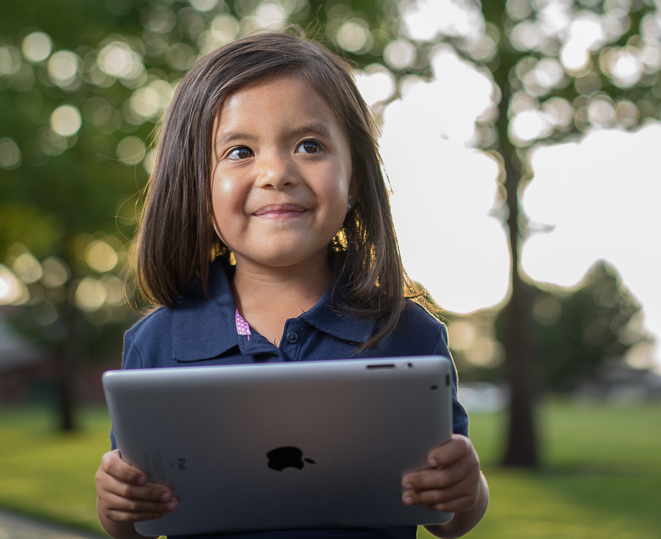What do screen time usage, internet safety, and plagiarism have in common? These topics all fall under the umbrella of digital citizenship.
We live in a world that is connected and, in some ways, defined by technology. To succeed in academics, and eventually in their career, all students need to learn how to navigate the digital world safely and responsibly. As an educator, you can help by teaching digital citizenship in your class.
Read on to discover what digital citizenship is and how it can help your students use technology in healthier ways. Then, find five tips and activities for teaching digital citizenship to young students.
What is Digital Citizenship?
The Internet as we know it now began to take shape in the early 1990s, and since then the digital world has become increasingly integrated in our daily lives.[13] Whether they’re surfing the web on a computer or playing games on their parent’s smartphone, many children use technology on a regular basis. That’s why teaching digital ethics is so important: to make sure students know how to use the Internet responsibly.
A broad definition of digital citizenship is the ability to use technology and the Internet in an appropriate manner. As technology continues to advance, so does the potential to abuse it (intentionally or otherwise).[8] Digital citizenship skills give students the right tools to engage with the digital world in ways that promote healthy online communities.
Because digital citizenship is such a wide-ranging topic, it can encompass a variety of concepts and actions. A few examples of digital citizenship include:
- Learning to type, use a mouse, and other computer skills
- Avoiding harassment or hateful speech while conversing with others online
- Encouraging yourself and others not to illegally download content or otherwise disrespect digital property
Exploring the 9 Elements of Digital Citizenship
Students live in a world where digital resources are everywhere, which is why the importance of including technology in education extends to all aspects of a student’s life. The International Society for Technology in Education (ISTE) outlines nine elements of digital citizenship to help students navigate online resources: [9]
- Digital access
- Digital etiquette
- Digital commerce
- Digital rights and responsibilities
- Digital literacy
- Digital law
- Digital communication
- Digital health and wellness
- Digital security
These nine elements form a guide for teaching students what they need to know to be safe and informed digital citizens.
Digital Access
Digital access involves the ability to connect with others or access information using technology. As a teacher, you can instruct students on how to find valuable and safe information on the Internet. You can also help children from disadvantaged communities use computers or other resources at school to increase their digital access.
 Digital Etiquette
Digital Etiquette
Digital etiquette is just what it sounds like: treating other Internet users with respect and avoiding inappropriate behavior. For elementary students, one of the most important digital etiquette principles is understanding the consequences of cyberbullying.
Digital Commerce
Digital commerce refers to buying and selling electronics responsibly. For the most part, elementary students do not need to learn or practice this element of digital citizenship. For middle or high school students, however, discussions around digital commerce can help them learn how to be better consumers or consider career paths related to digital sales.
Digital Rights and Responsibilities
Digital rights and responsibilities refers to the privileges that all students have while using the Internet, like freedom of speech.[10] It also involves a student’s duty to make sure that these rights remain available for everyone by treating other users fairly and respecting their privacy.
Digital Literacy
The definition of digital literacy is the ability to learn how to use technology and access information online.[12] A few examples of digital literacy include knowing how to use a mouse or how to find answers on a search engine.
Not all students start school with the same technological ability.[4] Teaching Internet skills in class can help bridge gaps in digital literacy.
Digital Law
Digital law encompasses the rules or guidelines set within an organization for using the Internet.[10] In your classroom, you could talk about preventing plagiarism or putting phones away in class to teach digital law.
 Digital Communication
Digital Communication
The options that students have for communicating online are greater than ever. Text, email, social media, and online games are all ways that children might digitally interact with others.[11] For this reason, it’s important to teach your students how to communicate safely and effectively online.
Digital Health and Wellness
This element of digital citizenship involves teaching students how to protect their psychological and physical well-being while using the Internet.[12] This could include practicing how to sit correctly in a chair while using the computer and avoiding too much screen time.
Digital Security
The ninth element of digital citizenship—digital security—involves teaching students how to take steps to stay safe online. Although the Internet can be an excellent resource, students need to know how to avoid viruses, scams, or strangers online. Internet safety lessons for children could include anything from why privacy online is important to what to do if they encounter a cyberbully or stranger.
Why Teach Digital Citizenship with Technology in the Classroom?
The benefits of digital citizenship for kids extend far beyond the individual.[8] When we help students develop healthy practices on the Internet, we’re also creating a better space for everyone they interact with. If your students use technology in class, digital citizenship curriculum is one of the best ways to help everyone make the most of their time online.
Because technology is so prevalent in schools, teachers often have to worry about how to prevent cyberbullying, cell phones disrupting class, and plagiarism.[1] Teaching digital citizenship can be one of the best ways to decrease these and other inappropriate behaviors at school.[14] As they become good digital citizens, students can use the Internet with a greater sense of self-awareness and better understand how to best use technology.
Teaching digital literacy and other citizenship skills can also help bridge digital equity gaps (or the “digital divide”) between students.[3] Not all students have the same level of access to technology at home. Students from under-resourced or marginalized communities often have fewer digital experiences in comparison to their peers.[4] When digital literacy is a core part of their education, the technological resources and lessons in school can help these students catch up with their classmates.
5 Digital Citizenship Activities and Tips for Elementary Students
For many children, technology is a part of their daily lives before they even begin school. That’s why it’s part of an educator’s duty to teach digital citizenship so students learn to interact in healthy ways with the online part of their world.
Use these digital citizenship game and lesson ideas to help elementary students develop essential skills for the wise and effective use of technology:
- Digital safety is important for everyone, but especially for young students. Teach your students internet safety tips, like how to keep personal information private or avoid talking with strangers online.[5]
- The earlier students learn know to use a keyboard and mouse, the better! Use your school’s technology lab to play typing games or teach students how to use a computer.
- Show students the variety of free resources they can use online, like Wikipedia or Google. Teach them not only how to access these resources but also how to use them safely.
- Cyberbullying can affect anyone, even elementary students. Brainstorm with your students how they can be respectful on the Internet and what to do if someone is bullying them.[6]
- To avoid plagiarism, teach older elementary students how to cite information that they find online.[7]
Sources:
Ribble, M.S., Bailey, G.D., and Ross, T.W. Digital Citizenship: Addressing Appropriate Technology Behavior. Learning & Leading with Technology, September 2004, 32(1), pp. 6-9.[1]
Lenhart, A., Madden, M., Smith, A., Purcell, K., Zickuhr, K., and Rainie, L. Teens, Kindness and Cruelty on Social Network Sites: How American Teens Navigate the New World of “Digital Citizenship.” Pew Internet & American Life Project, November 2011, pp. 1-86.[2]
Shelley, M., Thrane, L., Shulman, S., Lang, E., Beisser, S., Larson, T., and Mutiti, J. Digital Citizenship: Parameters of the Digital Divide. Social Science Computer Review, 2004, 22(2), pp. 256-269.[3]
Robinson, L., Cotten, S.R., Ono, H., Quan-Haase, A., Mesch, G., Chen, W., Schulz, J., Hale, T.M., and Stern, M.J. Digital inequalities and why they matter. Information, Communication, & Society. 2015, 18(5), pp. 569-582.[4]
Code.org and Common Sense Media. Digital Citizenship. Retrieved from code.org: https://code.org/curriculum/course3/20/Teacher.pdf.[5,6]
Hunter Library Services. Plagiarism and Copyright. Retrieved from libguides.com: https://huntertafe.libguides.com/digitalcitizenship/plagiarism.[7]
Farmer, L. Teaching Digital Citizenship. Selected Topics in Education and Educational Technology, January 2010, pp. 387-392.[8]
Ribble, M. Essential elements of digital citizenship. Retrieved from iste.org: https://www.iste.org/explore/ISTE-blog/Essential-elements-of-digital-citizenship.[9]
Ribble, M. Passport to Digital Citizenship: Journey Toward Appropriate Technology Use at School and at Home. Learning & Leading with Technology, December 2008, 36(4), pp. 14-17.[10]
Tan, T. Educating Digital Citizens. Leadership, September 2011, 41(1), pp. 30-32.[11]
Hollandsworth, R., Dowdy, L., and Donovan, J. Digital Citizenship in K-12: It Takes a Village. TechTrends, July 2011, 55(4), pp. 37-47.[12]
GCF Global. Internet 101: What is the Internet? Retrieved from just.edu.jo: www.just.edu.jo/~mqais/cis99/PDF/Internet.pdf.[13]
Reykdal, C. Cyberbullying and Digital/Internet Safety. Retrieved from www.k12.wa.us: https://www.k12.wa.us/student-success/health-safety/school-safety-center/z-index/cyberbullying-and-digitalinternet-safety.[14]


